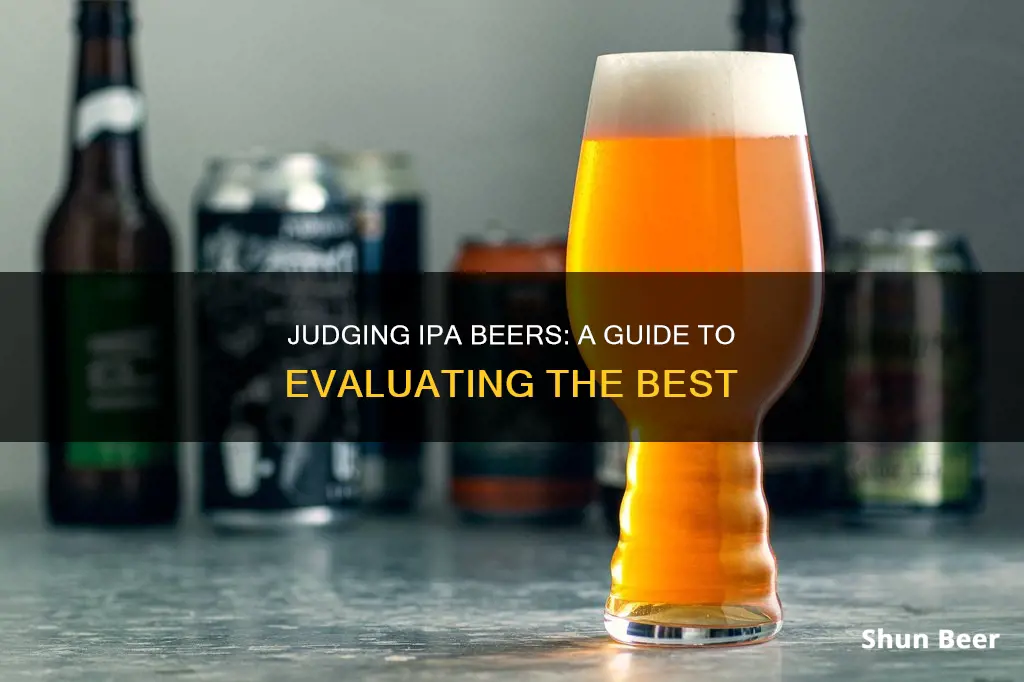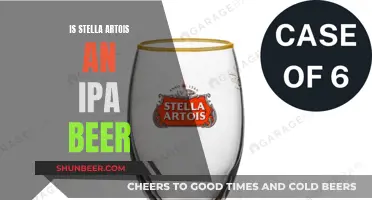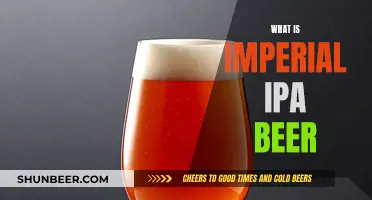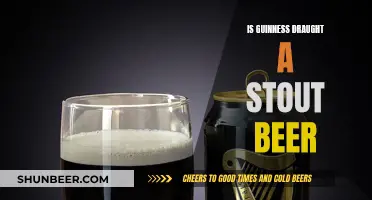
India Pale Ale (IPA) is a hoppy beer style that originated in Britain during the colonial era. The story goes that British sailors, unable to brew beer in the hot and humid climate of India, created a heavily hopped beer that could survive the long journey from Britain to India. IPAs have since evolved in terms of taste, but the hoppy quality has largely remained.
When judging an IPA, it's important to consider the different types and their unique characteristics. For example, a traditional West Coast IPA is hoppy, fruity, and crisp, while a New England-style IPA is hazy, with intense fruit flavours and a lower carbonation level. British IPAs, though less common, are also very hoppy but tend to be one-note.
Other factors to consider when judging an IPA include the alcohol content, with session IPAs having lower alcohol levels, and the bitterness, measured by International Bittering Units (IBU). The higher the IBU rating, the more bitter the IPA.
So, when judging an IPA, pay attention to the style, flavour profile, alcohol content, and bitterness to fully appreciate the unique characteristics of each brew.
What You'll Learn
- Aroma: the smell of an IPA can be influenced by the dry-hopping technique, which intensifies hop aromatics
- Flavour: the most popular IPAs tend to be fruity, but other flavours include Christmas and candy
- Alcohol content: IPAs can vary in strength, with session IPAs usually less than 5% ABV
- Bitterness: the bitterness of an IPA is determined by the number of hops used, which is measured by IBU
- Appearance: some IPAs are hazy, meaning you can't see through them

Aroma: the smell of an IPA can be influenced by the dry-hopping technique, which intensifies hop aromatics
The aroma of an IPA is a key part of its character, and dry hopping is a technique that can be used to intensify the hop aromatics. Dry hopping involves adding hops to the beer during or after fermentation, capturing the delicate volatile compounds that would otherwise be lost during boiling. This process imparts a strong aroma without adding any bitterness, as the hops are added after the liquid has cooled.
During the boiling process, the essential oils in the hops that provide floral and fruity notes can evaporate, and even a short time in boiling wort can destroy the potency of aromatic hops. By adding hops later in the process, brewers can preserve the flavour and aroma from the hops' oils. These oils add no bitterness, just flavour and aroma. The longer the boil time, the more oils are lost, so hops added at the beginning of the boil lose almost all of their oils. Even those added near the end of the boil lose quite a bit, and the heat induces chemical changes in the remaining oils, resulting in a loss of fresh hop aroma.
Dry hopping, therefore, allows brewers to capture the fresh hop aroma and enhance the taste of the beer. The hops are added after fermentation has begun, and the right time to add them is when fermentation starts to slow down. This is usually apparent by the head starting to diminish and a decrease in bubbling in the airlock. If hops are added too early, they can cause contamination in the beer. Waiting for the right time ensures that the beer's pH has fallen to a level where the organisms on the hops can't survive, and the alcohol serves to kill them.
The type of hops used can also make a difference. Hop oils are contained within the lupulin glands, which have been ruptured in pellets but are largely intact in whole hops. Pellets initially float but eventually settle at the bottom, while whole hops tend to float. Pellets allow all of the hop oils to get into the beer almost immediately, whereas whole hops can take up to a week or two to release a decent amount of oils.
The temperature also plays a role in the quality and strength of the hop aroma. Warmer temperatures tend to extract more oils than colder temperatures, and a rule of thumb for fermenter dry hopping is to aim for around 70 °F (21 °C).
In summary, dry hopping is a technique that intensifies the hop aromatics in an IPA by adding hops after fermentation has begun, capturing the volatile compounds and oils that give the beer its unique aroma and flavour. By understanding the science behind dry hopping and experimenting with different types of hops and temperatures, brewers can create IPAs with captivating aromas that resonate with beer enthusiasts.
Guinness Beer: Why Do Bubbles Go Down?
You may want to see also

Flavour: the most popular IPAs tend to be fruity, but other flavours include Christmas and candy
When it comes to flavour, the most popular IPAs tend to be fruity, but other flavours include Christmas and candy.
IPAs are known for their hoppy, bitter taste, but the specific flavours depend on the style of IPA and the hops used. For example, a West Coast IPA will typically have strong notes of citrus and tropical fruit, while a New England IPA might taste like fruit salad or fresh fruit cobbler.
The hops in an IPA can also lend flavours like pine, florals, and earthiness. And while it's less common, some IPAs might have candy-like sweetness or Christmas-like spices.
The type of hops used can also affect the flavour. For instance, American "C" hops are often used in West Coast IPAs and can impart flavours of citrus and tropical fruit. On the other hand, East Coast IPAs might use a combination of American and local hops, resulting in a unique flavour profile.
Additionally, other ingredients can be added to an IPA to enhance its flavour. For example, Belgian IPAs often use Belgian yeast, resulting in sweet, bready, and warm notes. Lactose IPAs, or "milkshake" IPAs, have added milk sugar, giving them a creamy, fruity flavour.
Booze in Beer: IPAs Boomsauce Alcoholic Secrets
You may want to see also

Alcohol content: IPAs can vary in strength, with session IPAs usually less than 5% ABV
When it comes to judging an IPA beer, one of the key factors to consider is its alcohol content. India Pale Ales (IPAs) can vary significantly in strength, and understanding the different types of IPAs and their alcohol content can help you make a more informed choice.
Session IPAs, for example, are designed for those who want to enjoy the flavour of an IPA but prefer a lower alcohol content. These beers typically appear thinner in body compared to other IPAs and usually have an alcohol content of less than 5% ABV. Historically, session IPAs were 4% ABV or lower, but modern versions often fall just below 5%. With their lower alcohol content, session IPAs are perfect for drinking in repeat sessions, as their name suggests.
On the other hand, Double or Imperial IPAs are stronger variants with a higher alcohol content. These beers usually have an ABV of 7% or more, and sometimes even exceed 7.5%. The term "double" refers to the increased amount of ingredients, particularly hops, used in brewing. This results in a beer that is not only higher in alcohol but also richer in hop character.
The alcohol content of IPAs can also vary based on their style or regional variations. For instance, English-style IPAs typically have an ABV range of 5-7%, while American IPAs tend to fall within the range of 5.5-7.5%. Additionally, Belgian IPAs often have a higher alcohol content, ranging from 6.5-9% ABV.
When judging an IPA, it is essential to consider not only the alcohol content but also how it complements the other characteristics of the beer, such as its flavour, aroma, and body. The alcohol content can significantly impact the overall drinking experience, influencing factors such as drinkability, sessionability, and the intensity of flavours.
By understanding the different alcohol strengths and variations among IPAs, you can make more informed choices based on your personal preferences and desired drinking experience.
Guinness Beer: Carbonation Secrets Revealed
You may want to see also

Bitterness: the bitterness of an IPA is determined by the number of hops used, which is measured by IBU
When judging an IPA beer, one of the most important factors to consider is its bitterness. The bitterness of an IPA is largely determined by the number of hops used in the brewing process, and this is measured by International Bitterness Units (IBU). IBUs quantify the beer's bitterness by assessing the concentration of bittering compounds, specifically isomerized and oxidized alpha acids, polyphenols, and a few other bittering chemicals. The higher the IBU rating, the more bitter the IPA will be.
The IBU scale was introduced in the early 20th century to quantify and assess the bitterness of beer. The scale typically ranges from 0 to 120, with 5 being very low bitterness and 120 being very high bitterness. However, it's important to note that the IBU scale only measures bitterness and does not account for other factors that affect the overall taste of the beer, such as malt character and sweetness. For example, a beer with 20 IBUs and minimal malt character may taste significantly more bitter than a beer with 60 IBUs and a strong malt profile.
Most IPAs fall within the IBU range of 40 to 70, but this can vary depending on the specific style of IPA. For instance, a West Coast IPA will typically have an IBU range of 50 to 70, while a Hazy Double IPA may have an IBU range of 45 to 80.
While the IBU scale provides a general guideline for bitterness, it's not a perfect indicator of how a beer will taste. The human palate can generally perceive bitterness up to a certain point, often around 100 IBUs, after which additional bitterness may not be discernible. Additionally, factors such as malt sweetness, alcohol content, and individual taste sensitivity can also influence the perceived bitterness of an IPA.
Guinness: The Healthiest Beer Option?
You may want to see also

Appearance: some IPAs are hazy, meaning you can't see through them
When judging an IPA beer, the first thing you notice is its appearance. Some IPAs are hazy, with a cloudy appearance that makes it impossible to see through them. This haziness is not just about looks, it hints at a fullness of flavour. Hazy IPAs are also known as New England IPAs or New England-style IPAs, and they have become extremely popular.
The haziness of these beers is due to the presence of solid matter from beer ingredients, which are usually microscopic compounds. The main component is grain protein, which is more prevalent in wheat than barley. Haze can also be formed by solid compounds from hop oils (called polyphenols) and starch from oats. In the case of beers with added fruit, like Stone Tangerine Express Hazy IPA, fruit pectins contribute to the haze. These compounds are big and insoluble, and with the right recipe and brewing techniques, they remain colloidal in the beer, giving it a consistent and attractive haze.
Hazy IPAs are not filtered, which is a step that is usually done to give beer a clear appearance. However, this does not mean that all unfiltered beers will be hazy. The haziness is achieved by striking a delicate balance between the right ingredients and processes. Brewers often use wheat, oats, or a combination of both in addition to barley. They also select hops that are high in tropical, fruity aroma compounds. It is important to ensure that the beer is dense enough to keep the haze suspended, which means that it should not be fermented too dry.
The haze in Hazy IPAs is not just about aesthetics, it also affects the mouthfeel and flavour of the beer. The solid compounds in the haze give the beer a thick and satisfying mouthfeel. Additionally, hop aroma compounds tend to stick to these compounds, resulting in a beer with a big punch of hop flavour and aroma. The haziness of Hazy IPAs is thus a carefully crafted feature that contributes to their unique characteristics and popularity.
Guinness Beer: Meat-Free, But What's the Verdict?
You may want to see also
Frequently asked questions
IPA stands for Indian Pale Ale or India Pale Ale.
A West Coast IPA is hoppy, fruity, and crisp, while a New England IPA is hazy, with intense fruit flavours and a grassy aroma.
A Double IPA, also known as an Imperial IPA, is a stronger, hoppier variant of an IPA with an alcohol content of 7% or more.
An IPA is a hopped-up, stronger version of a Pale Ale. However, this is not a hard and fast definition, as Pale Ales have become stronger and hoppier over time.
IPAs will not go "bad" but they will go stale. For optimum flavour, an IPA should be consumed within three weeks of its production date.







